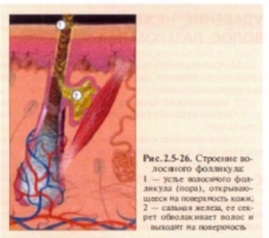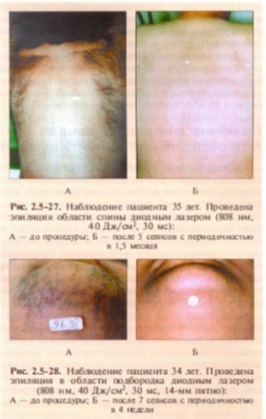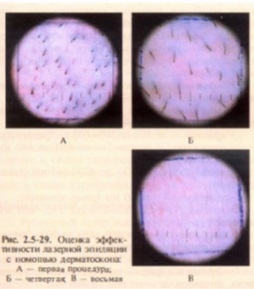Proper skin care before and after the procedure has a great influence on the final result of laser hair removal.
The structure of the hair follicle
Hair follicle (lat. follikulus pili – hair follicle) – the hair root together with the root sheath surrounding it. Attached to the follicle are the sebaceous glands, and sometimes the sweat gland. The hair shaft in cross section consists of an internal medulla (absent in vellus hair), a middle cortical substance, and a cuticle. The medulla consists of not yet keratinized cells, and the cortical layer – from keratinized cells and makes up about 90% of the total mass of the hair. The cells of this layer contain pigments, the ratio of which determines hair color: eumelanin (black-brown) and pheomelanin (yellow-red).
 Vladimir Alexandrovich Tsepkolenko
Vladimir Alexandrovich Tsepkolenko
MD, Professor, Honored Doctor of Ukraine,
President of the Ukrainian Society of Aesthetic
Medicine, General Director of the Ukrainian
Institute of Plastic Surgery
and aesthetic medicine "Virtus"
However, not all areas of the hair are pigmented, which complicates the laser hair removal procedure. Moreover, some of them are distant from the pigmented parts: the stem cells of the follicle, which make up the outer part of the epithelial sheath of the hair root, together with the attachment of the muscle that straightens the hair. At the bottom of the follicle is a fairly large hair papilla (formed from connective tissue and a network of blood vessels) that controls hair growth. If during epilation it was not possible to destroy this element, then a new – temporary rather than permanent hair removal (fig. 2.5-2.6).

There are three stages of follicle development: anagen (growth period), catagen and telogen (rest period). Normally, in a healthy person, 80-90% of the hair is in the anagen stage, 10-15% is in the telogen stage and 1-2% is in the catagen stage. It is noted that the hair in the anagen phase is more sensitive to laser radiation, and the hair in the catagen and telogen phase is less sensitive. For complete hair removal, several (3-5) sessions are required at intervals of 2-3 months.
Photothermal hair removal is based on the principle of selective photothermolysis. In the visible and near infrared ranges of light waves, the role of the main chromophore of hair follicles is played by melanin, which is located in the hair shaft, the outer epithelial sheath and the area of the intercellular matrix. Light with a wavelength of 600-1100 nm penetrates deep enough into the skin and is well absorbed by melanin with weak absorption by hemoglobin and water, carrying out selective heating and photothermolysis of the hair shaft, hair follicle epithelium and pigmented extracellular matrix.
According to the selective photothermolysis technique, the pulse duration should be less than the thermal relaxation time of the follicle (20-100 ms depending on its size), otherwise the heat diffusion from the hair shaft leads to heating of the surrounding structures.
Non-pigmented areas of the follicle cannot be directly heated by light, so to remove them, you have to increase the pulse duration (exceeding the thermal relaxation time of the pigmented part) so that the heat has time to spread over a larger area, damaging the target transparent cells. Heating with long pulses (> 100 ms) leads to long-term hair removal, but with a high risk of damage to the epidermis. Histological examination shows selective thermal damage to pigmented hair follicles with vaporization of the rods, large areas of necrosis in the epithelium of the follicles, and in some places ruptures and interfollicular lesions of the dermis.
Dark skin (tanning) increases non-specific heating, but epidermal cooling minimizes possible undesirable effects. The most commonly used are ice packs, cooling gel pads, chilled airflow, cryogenic sprays, or chilled sapphire lenses.
Photochemical hair removal – the use of photosensitizers for targeted chemical exposure. Currently, such methods are at the stage of formation and clinical trials, therefore they cannot be recommended for mass use.
There are three main mechanisms of destruction of the hair follicle under the influence of laser radiation:
- thermal (local heating);
- mechanical (shock wave or severe cavitation);
- photochemical (production of singlet oxygen and free radicals).
The main millisecond lasers used for hair removal
Ruby laser, 694 rm
The light of this laser is very intensely absorbed by melanin, and further reduction of the wavelength is almost impossible due to a significant increase in absorption by hemoglobin (Table 6). The depth of penetration of light, although sufficient, is significantly inferior to other epilation lasers. Treatment of skin of IV-VI phototypes according to Fitzpatrick is undesirable, the ideal option is – skin types I-II, on which it is possible to remove almost any hair. To protect the epidermis, epidermal cooling is recommended.
Table 6. Characteristics of the main hair removal lasers
| Laser type | Wavelength, nm | Pulse duration, ms | Radiation energy density, J/cm2 | Skin type | Hair color | Hair diameter |
| Ruby | 694 | 10-50 | 10-50 | I-III | Dark to light brown | Thick and thin |
| Alexandrite | 755 | 1-300 | 10-50 | I-VI | Dark to light brown | Thick and thin |
| Diode | 800 | 5-700 | to 100 | I-VI | Dark to light brown | Thick |
| Nd:YAG | 1064 | 1-300 | up to 600 | I-VI | Dark | Thick |
Alexandrite laser, 755 nm
The average depth of penetration of this laser into the skin is somewhat greater than that of ruby, but less than that of diode or Nd:YAG lasers. By the intensity of light absorption by melanin, on the contrary, it is second only to the ruby laser, which complicates the processing of dark skin, but allows you to remove even thin and relatively light hair, which is almost impossible when using lasers with a wavelength of more than 800 nm.
Diode lasers, 800-900 nm
Powerful diode lasers are often used for hair removal. The main reason for this popularity is the relatively long wavelength, which provides a sufficient penetration depth of radiation, which is significantly absorbed by melanin. These lasers – “golden mean” between ruby and neodymium lasers. As has been repeatedly mentioned, the long wavelength, relatively long pulses and the use of external skin cooling make it possible to more effectively treat both dark skin types and skin with a significant tan (fig. 2.5-27, fig. 2.5-28).

Nd:YAG laser, 1064 nm
The advantages of a millisecond Nd:YAG laser – the possibility of processing all types of skin (especially with the use of epidermal cooling) and a large depth of light penetration, which allows you to directly heat even deeply located areas of the hair.
Lack of – relatively weak absorption of light by melanin, requiring the use of high radiation power density and not allowing the removal of thin or light hair.
Long-wavelength lasers (900-1100 nm) can also be used to combat the problem of ingrown hairs, which often occurs after constant shaving and is especially relevant for patients with Fitzpatrick skin types IV-VI.
Practical recommendations for laser hair removal
Among the factors affecting the processing result, the following should be highlighted:
- hair color and skin color of the patient;
- hair type and density;
- hormonal factor;
- anatomical localization.
Laser hair removal is best for patients with light skin tone and thick dark hair, who do not have pathologies from the endocrine system. Modern technologies do not allow you to successfully remove light and thin vellus hair. Proper skin care before and after the procedure has a great influence on the final result.
In patients with fair hair, hair removal with a short wavelength laser (eg, ruby) is possible, and dark hair can be removed with any laser (preferably using a diode or alexandrite, which cause less off-target heating). At low laser power (less than 50% of the recommended one), there is almost zero efficiency of the procedure due to insufficient heating of even the pigmented parts of the hair. Longer pulses and cooling reduces the risk of side effects.
The use of repeated (double or triple) pulses of less than usual power allows maintaining the temperature necessary for its destruction in the contrast follicle, but gives the surrounding tissues time to cool down (since its thermal relaxation time is much shorter than that of the follicle). This technique increases the safety of treating dark (or tanned) skin.
It is recommended to devote the first procedure to finding the optimal laser settings: from 3 to 10 pulses of different power are produced, the evaluation criterion is the presence of mild symptoms of folliculitis after 20-40 minutes, the absence of which indicates insufficient power.
A single treatment results in a reduction in the number of growing hairs by no more than 30%, and after 3-4 sessions, their number can be reduced by 40-70%. Repeated treatments are necessary due to the fact that only pigmented hair is exposed to laser treatment. A significant portion of the hair is in other stages of the natural growth cycle of 6-8 weeks, so it can be processed after at least half of this period.
Additional recommendations
Preoperative period:
- For a month before laser hair removal, it is recommended to avoid sun exposure and use sunscreens with a high protection factor and zinc oxide. If whitening therapy is needed, hydroquinone, kojic, retinoic and AHA acids are used. Plucking and waxing are not recommended, as the presence of a hair shaft inside the follicle increases the effectiveness of laser hair removal. Shaving and depilatory creams do not have a significant effect on the result.
- The day before laser hair removal, the hair is removed with a razor. If there are indications – prophylactic antibiotics or antivirals.
Assessing the results of laser hair removal
Temporary or permanent hair loss is possible as a result of laser treatment. The most likely temporary loss of – delayed hair growth for 1-3 months (corresponding to the duration of the telogen phase). With permanent hair loss, their number is significantly reduced for a period longer than the growth cycle. Complete loss – reducing to almost zero the number of new hair – may be temporary or permanent. Usually, after laser treatment, there is a complete, but temporary hair loss for 1-3 months; part of the hair falls out forever. Damaged hair falls out within 5-10 days, and new hair often grows thinner and lighter, which contributes to the overall cosmetic result.
The effectiveness of hair removal for a long time directly depends on their color and energy density of the radiation. Since hair loss is up to 20-25% with each treatment, several treatments are required for complete removal. In rare cases, patients have a very weak response to treatment (and even stimulation of hair growth), which is most often caused by a hormonal factor.
To assess the effectiveness of laser hair removal, it is recommended to use dermatoscopy followed by counting the number of hairs: a decrease in their number by 20% in one procedure indicates a high efficiency of laser hair removal, less than 10% indicates insufficient efficiency (Fig. 2.5-29).

Side effects and complications, their management
Complications are rare if safety precautions are followed and the patient's skin is taken into account. Side effects include the following:
- pain during and immediately after treatment;
- perifollicular erythema and edema (appear within half an hour after the procedure);
- pigmentation changes (5-10%, more likely in tanned or dark-skinned patients).
As a rule, hyperpigmentation resolves on its own within 4-6 months. Increasing the pulse duration to 15-20 ms reduces the intensity of hyperpigmentation and reduces the time to restore skin color.
The risk of scarring is minimal except in cases of overly aggressive treatment or postoperative infection. Possible disappearance of freckles and lightening of tattoos.
If itching and blisters appear (indicative of excessive laser power), it is recommended to use topical corticosteroids, antihistamines and suspend laser therapy.
Side effects are more likely to occur in patients who have had herpes simplex, as well as in laser treatment of the skin of the perioral, pubic or bikini areas. Bacterial infections can also be a consequence of damage to the epidermis. Folliculitis may occur during laser treatment of areas characterized by profuse sweating or strenuous exercise.
Hot baths and swimming are not recommended during laser therapy sessions, as they increase the susceptibility of the skin to painful factors.
There have been cases of temporary or permanent leukotrichia (hair discoloration) associated with the destruction (or reduced functionality) of melanocytes with insufficient damage to the cells of the hair follicles.
To be continued.







Add a comment